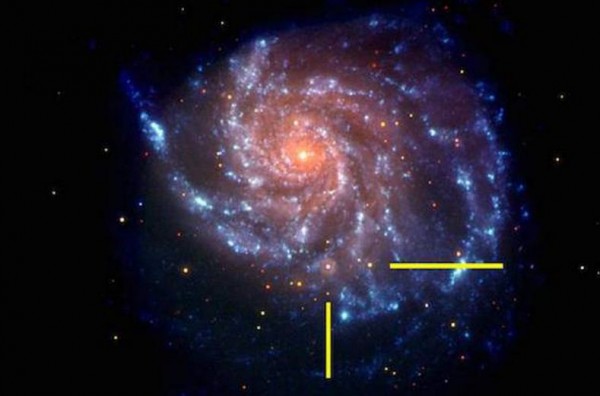Universe Might Not be Expanding as Fast as Believed
| Arthur Dominic Villasanta | | Apr 11, 2015 11:29 PM EDT |
Galaxy M101 shown with bars indicating location of supernova SN 2011fe.
The Universe might be expanding at a slower rate than theorized because there's apparently not as much dark energy present to propel this inflation.
A new study by a team of astronomers from the University of Arizona raised questions about how fast the Universe has expanded since the Big Bang occurred 13.8 billion years ago.
Like Us on Facebook
Their "big cosmological questions" was sparked by a discovery that the type of supernovae commonly used to measure distances throughout the Universe (much like a cosmic ruler) wasn't unvarying but actually falls into different categories and isn't as uniform as once thought.
The realization that the amount of light observed in "Type Ia supernovae" used to measure interstellar distances varied more than had been previously believed means theories about the acceleration of the universe might be faulty.
Astronomers use the Type Ia supernova to determine cosmic distances. This category of supernovae produces consistent peak luminosity because of the uniform mass of white dwarfs that explode via the accretion mechanism.
The stability of this value allows these explosions to be used as "standard candles" to measure the distance to their host galaxies because the visual magnitude of the supernovae depends primarily on the distance.
Type Ia supernovae occur in a binary system, or two stars orbiting one another. One of the stars in the system must be a white dwarf star, or the dense, carbon remains of a star about the size of our Sun.
"We're proposing that our data suggest there might be less dark energy than textbook knowledge, but we can't put a number on it," said Peter Milne of the University of Arizona.
"Until our paper, the two populations of supernovae were treated as the same population. To get that final answer, you need to do all that work again, separately for the red and for the blue population."
He said their findings are analogous to sampling a selection of 100 watt light bulbs and discovering they varied in brightness.
"We found that the differences are not random, but lead to separating Ia supernovae into two groups, where the group that is in the minority near us are in the majority at large distances - and thus when the universe was younger," said Milne
"There are different populations out there, and they have not been recognized. The big assumption has been that as you go from near to far, type Ia supernovae are the same. That doesn't appear to be the case."
To reach this stunning conclusion, the team observed a large sample of type Ia supernovae in ultraviolet and visible light and combined datasets from the Swift satellite and the Hubble space telescope:
The discovery Type Ia supernovae are not reliable indicators of distance, and could be closer than thought, means the expansion of the Universe is not accelerating rapidly after all.
A significant implication of this finding is there may be much less dark energy than previously thought, since dark energy is believed to contribute to rapid expansion. Dark energy is believed to account for as much as 75 percent of the mass of the Universe and is the main force behind cosmic inflation or the unrelenting expansion of the Universe.
©2015 Chinatopix All rights reserved. Do not reproduce without permission
EDITOR'S PICKS
-

Did the Trump administration just announce plans for a trade war with ‘hostile’ China and Russia?
-

US Senate passes Taiwan travel bill slammed by China
-

As Yan Sihong’s family grieves, here are other Chinese students who went missing abroad. Some have never been found
-

Beijing blasts Western critics who ‘smear China’ with the term sharp power
-

China Envoy Seeks to Defuse Tensions With U.S. as a Trade War Brews
-

Singapore's Deputy PM Provides Bitcoin Vote of Confidence Amid China's Blanket Bans
-

China warns investors over risks in overseas virtual currency trading
-

Chinese government most trustworthy: survey
-

Kashima Antlers On Course For Back-To-Back Titles
MOST POPULAR
LATEST NEWS
Zhou Yongkang: China's Former Security Chief Sentenced to Life in Prison

China's former Chief of the Ministry of Public Security, Zhou Yongkang, has been given a life sentence after he was found guilty of abusing his office, bribery and deliberately ... Full Article
TRENDING STORY

China Pork Prices Expected to Stabilize As The Supplies Recover

Elephone P9000 Smartphone is now on Sale on Amazon India

There's a Big Chance Cliffhangers Won't Still Be Resolved When Grey's Anatomy Season 13 Returns

Supreme Court Ruled on Samsung vs Apple Dispute for Patent Infringement

Microsoft Surface Pro 5 Rumors and Release Date: What is the Latest?










